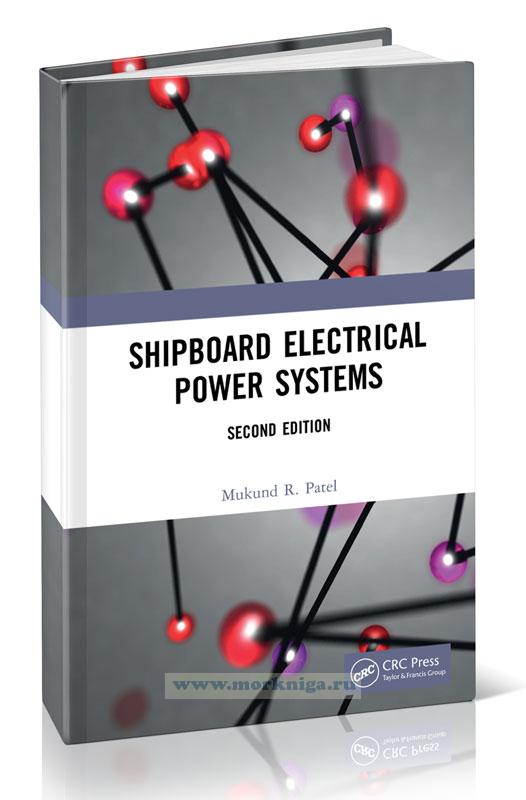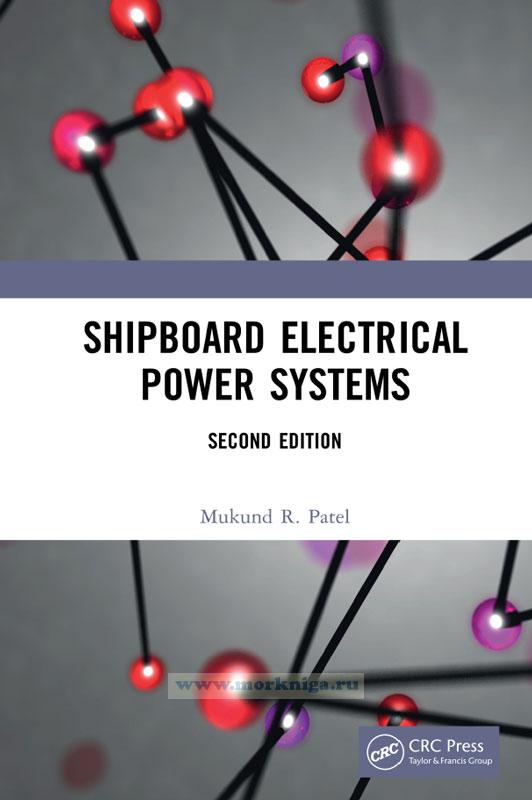Сб с 10 до 16
Shipboard Electrical Power Systems/Судовые электроэнергетические системы
Издание на английском языке
This book, now in its second edition, will continue to serve the need of marine engineers under training, or sailing on ships, or working in the ship building companies, or on ports, or in the navies around the world. In addition, many countries are presently experiencing a shortage of engineers with power engineering background. As a result, many university students are now once again attracted to electrical power engineering programs. This book can serve them as well.
Contents
Preface
Acronyms and Abbreviations
Acknowledgments
About the Author
Introduction
Chapter 1 AC Power Fundamentals
1.1 Current Voltage Power and Energy
1.2 Alternating Current
1.2.1 RMS Value and Average Power
1.2.2 Polarity Marking in AC
1.3 Ac Phasor
1.3.1 Operator j for 90° Phase Shift
1.3.2 Three Ways of Writing Phasors
1.3.3 Phasor Form Conversion
1.4 Phasor Algebra Review
1.5 Single-Phase Ac Power Circuit
1.5.1 Series R-L-C Circuit
1.5.2 Impedance Triangle
1.5.3 Circuit Laws and Theorems
1.6 Ac Power in Complex Form
1.7 Reactive Power
1.8 Three-Phase Ac Power System
1.8.1 Balanced y- and -Connected systems
1.8.2 Y- Equivalent Impedance Conversion
Further Reading
Chapter 2 Shipboard Power System Architectures
2.1 Types of Ship Drives
2.2 Electrical Design Tasks
2.3 Electrical Load Analysis
2.3.1 Load Factor or Service Factor
2.3.2 Load Table Compilation
2.4 Power System Configurations
2.4.1 Basic Conventional Ship
2.4.2 Large Cargo Ship
2.4.3 Large Cruise Ship
2.4.4 Ring Bus in Navy Ship
2.4.5 ABS-R2 Redundancy Class of Ship
2.4.6 ABS-R2S Redundancy with Separation
2.4.7 ABS-R2S+ with Two-Winding Propulsion
Motors
2.4.8 Clean Power Bus for Harmonic-Sensitive
Loads
2.4.9 Emergency Generator Engine Starting
System
2.5 Cold-Ironing/Shore Power
2.6 Efficiency and Reliability of Chain
2.7 Shipboard Circuit Designation
2.8 Ship Simulator
2.9 Systems of Units
Further Reading
Chapter 3 Common Aspects of Power Equipment
3.1 Faraday’s Law and Coil Voltage Equation
3.2 Mechanical Force and Torque
3.3 Electrical Equivalent of Newton’s Third Law
3.4 Power Losses in Electrical Machine
3.5 Maximum Efficiency Operating Point
3.6 Thevenin Equivalent Source Model
3.7 Voltage Drop and Regulation
3.8 Load Sharing Among Sources
3.8.1 Static Sources in Parallel
3.8.2 Load Adjustment
3.9 Power Rating of Equipment
3.9.1 Temperature Rise under Load
3.9.2 Service Life under Overload
3.10 Temperature Effect on Resistance
Further Reading
Chapter 4 AC Generator
4.1 Terminal Performance
4.2 Electrical Model
4.3 Electrical Power Output
4.3.1 Field Excitation Effect
4.3.2 Power Capability Limits
4.3.3 Round and Salient Pole Rotors
4.4 Transient Stability Limit
4.5 Equal Area Criteria of Transient Stability
4.6 Speed and Frequency Regulations
4.7 Load Sharing Among Ac Generators
4.8 Isosynchronous Generator
4.9 Excitation Methods
4.10 Short Circuit Ratio
4.11 Automatic Voltage Regulator
Further Reading
Chapter 5 AC and DC Motors
5.1 Induction Motor
5.1.1 Performance Characteristics
5.1.2 Starting Inrush kVA Code
5.1.3 Torque-Speed Characteristic Matching
5.1.4 Motor Control Center
5.1.5 Performance at Different Frequency and Voltage
5.2 Synchronous Motor
5.3 Motor Hp and Line Current
5.4 Dual-use Motors
5.5 Unbalanced Voltage Effect
5.6 Dc Motor
5.7 Universal (Series) Motor AC or DC
5.8 Special Motors for Ship Propulsion
5.9 Torque Versus Speed Comparison
Further Reading
Chapter 6 Transformer
6.1 Transformer Categories
6.2 Types of Transformers
6.3 Selection of Rating
6.4 Transformer Cooling Classes
6.5 Three-Phase Transformer Connections
6.6 Full- and Open- Connections
6.7 Magnetizing Inrush Current
6.8 Single-Line Diagram Model
6.9 Three-Winding Transformer
6.10 Percent and Per Unit Systems
6.11 Equivalent Impedance at Different Voltage
6.12 Continuous Equivalent Circuit Through Transformer
6.13 Influence of Transformer Impedance
Further Reading
Chapter 7 Power Cable
7.1 Conductor Gage
7.2 Cable Insulation
7.3 Conductor Ampacity
7.4 Cable Electrical Model
7.5 Skin and Proximity Effects
7.6 Cable Design
7.7 Marine and Special Cables
7.8 Cable Routing and Installation
Further Reading
Chapter 8 Power Distribution
8.1 Typical Distribution Scheme
8.2 Grounded and Ungrounded Systems
8.3 Ground Fault Detection Schemes
8.4 Distribution Feeder Voltage Drop
8.4.1 Voltage Drop During Motor Starting
8.4.2 Voltage Boost by Capacitors
8.4.3 System Voltage Drop Analysis
8.5 Bus Bars Electrical Parameters
8.6 High-Frequency Distribution
8.7 Switchboard and Switchgear
8.7.1 Automatic Bus Transfer
8.7.2 Disconnect Switch
Further Reading
Chapter 9 Fault Current Analysis
9.1 Types and Frequency of Faults
9.2 Fault Analysis Model
9.3 Asymmetrical Fault Transient
9.3.1 Simple Physical Explanation
9.3.2 Rigorous Mathematical Analysis
9.4 Fault Current Offset Factor
9.5 Fault Current Magnitude
9.5.1 Symmetrical Fault Current
9.5.2 Asymmetrical Fault Current
9.5.3 Transient and Subtransient Reactance
9.5.4 Generator Terminal Fault Current
9.5.5 Transformer Terminal Fault Current
9.6 Motor Contribution to Fault Current
9.7 Current Limiting Series Reactor
9.8 Unsymmetrical Faults
9.9 Circuit Breaker Selection Simplified
Further Reading
Chapter 10 System Protection
10.1 Fuse
10.1.1 Fuse Selection
10.1.2 Types of Fuse
10.2 Overload Protection
10.3 Electromechanical Relay
10.4 Circuit Breaker
10.4.1 Types of Circuit Breaker
10.4.2 Circuit Breaker Selection
10.5 Differential Protection of Generator
10.6 Differential Protection of Bus and Feeders
10.7 Ground Fault Current Interrupter
10.8 Transformer Protection
10.9 Motor Branch Circuit Protection
10.10 Lightning and Switching Voltage Protection
10.11 Surge Protection for Small Sensitive Loads
10.12 Protection Coordination
10.13 Health Monitoring
10.14 ARC Flash Analysis
Further Reading
Chapter 11 Economic Use of Power
11.1 Economic Analysis
11.1.1 Cash Flow with Borrowed Capital
11.1.2 Payback of Self-Financed Capital
11.2 Power Loss Capitalization
11.3 High Efficiency Motor
11.4 Power Factor Improvement
11.4.1 Capacitor Size Determination
11.4.2 Parallel Resonance with Source
11.4.3 Safety with Capacitors
11.4.4 Difference between PF and Efficiency
11.5 Energy Storage During Night
11.6 Variable Speed Motor Drives AC and DC
11.7 Regenerative Braking
11.7.1 Induction Motor Torque versus Speed Curve
11.7.2 Induction Motor Braking
11.7.3 DC Motor Braking
11.7.4 New York and Oslo Metro Trains
Further Reading
Chapter 12 Electrochemical Battery
12.1 Major Rechargeable Batteries
12.1.1 Lead Acid
12.1.2 Nickel Cadmium
12.1.3 Nickel Metal Hydride
12.1.4 Lithium Ion
12.1.5 Lithium Polymer
12.1.6 Sodium Battery
12.2 Electrical Circuit Model
12.3 Performance Characteristics
12.3.1 Charge/Discharge Voltages
12.3.2 c/d Ratio (Charge Efficiency)
12.3.3 Round Trip Energy Efficiency
12.3.4 Self-Discharge and Trickle-Charge
12.3.5 Memory Effect in NiCd
12.3.6 Temperature Effects
12.4 Battery Life
12.5 Battery Types Compared
12.6 More on the Lead-Acid Battery
12.7 Battery Design Process
12.8 Safety And Environment
Further Reading
Chapter 13 Electric Propulsion
13.1 State of Electric Propulsion
13.2 Types of Electric Propulsion Drive
13.2.1 Azimuth Z-drive
13.2.2 Azimuth Pod-Drive
13.3 Propulsion Power System Configurations
13.3.1 Separate Electrical Propulsion Power
13.3.2 Integrated Electric Propulsion Power
13.4 Advantages of Electric Propulsion
13.4.1 Advantages to Cruise and Navy Ships
13.4.2 Special Advantages to Navy Ships
13.5 AC Vs. DC Power Option
13.6 Optimum Voltage Level
13.7 Propulsion Power Requirement
13.8 Ship Speed vs. Fuel Consumption
13.9 Hybrid Propulsion
13.9.1 Hybrid Tug Boat
13.9.2 Hybrid Ferry
Further Reading
Chapter 14 Ship Emission Regulations and Clean Power Technologies
14.1 Overview of Ship Emissions
14.2 Key Marine Air Pollutants
14.3 Marine Emission Regulations
14.4 Means of Emission Reduction
14.4.1 Low Sulfur Fuel Switching
14.4.2 Speed Reduction (Slow Steaming)
14.4.3 Using Shore power at Port (Cold Ironing)
14.4.4 Using Liquified Natural Gas (LNG)
14.4.5 Using Scrubbers
14.5 Clean Power Technologies
14.5.1 Fuel Cell Power
14.5.1.1 Electrochemistry
14.5.1.2 Electrical Performance
14.5.1.3 Types of Fuel Cell
14.5.1.4 Fuel Cells for Navy and Military Use
14.5.1.5 Fuel Cell in Merchant Ships
14.5.2 Lithium-Ion Batteries
14.5.3 Solar Photovoltaics
14.5.4 Wind Power
Further Reading
Chapter 15 Marine Industry Standards
15.1 Standard-Issuing Organizations
15.2 Classification Societies
15.3 Ieee Standard-45
15.4 Code of Federal Regulations
15.5 Military-Std-1399
Further Reading
Appendix A: Symmetrical Components
Appendix B: Operating Ships Power System Data Example
Index

